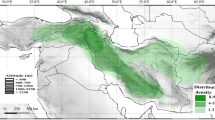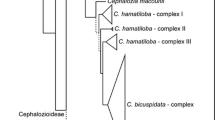Abstract
The systematics and phylogeny of the genusCochlearia and allied genera are unsettled. There are no clearly defined genera and subtribal structures to determine subtribeCochleariinae in respect to subtribeThlaspidinae. The use of morphological data, such as fruit form or embryo characters have resulted in contradictory taxonomic concepts in the past due to their homoplastic nature. We investigated all sections of genusCochlearia recognised in the most common concepts, as well as some genera such asIonopsidium, Bivonaea, Pastorea andThlaspi s. l. pro parte. Previous studies based on molecular data and morphological studies have shown close relationships between taxa from subtribeCochleariinae andThlaspidinae. The Internal Transcribed Spacer regions of the nuclear encoded ribosomal DNA operon and the plastidictrnL intron were sequenced from a number of genera. A molecular phylogeny was derived and compared to traditional classification systems. These data grouped sections ofCochlearia outside theCochlearial Ionopsidium core group and integrated them either closely to genusNoccaea in subtribeThlaspidinae (sect.Pseudosempervivum) or positioned them outside both theCochlearia core group and theThlaspi s. l. clade (sect.Hilliella). The molecular data indicate that subtribal arrangements in tribeLepidieae are artificial and do not reflect evolutionary history. The genusCochlearia is represented by sectionsCochlearia andGlaucocochlearia and the genusIonopsidium should be integrated intoCochlearia.
Similar content being viewed by others
References
Avetisian, V. E., 1983: The system of the familyBrassicaceae. — Bot. Zhurn. (Moscow & Leningrad)68: 1297–1305.
Baldwin, B. G., Sanderson, M. J., Porter, J. M., Wojciechowski, M. F., Campbell, C. S., Donoghue, M. J., 1995: The ITS region of nuclear ribosomal DNA: a valuable source of evidence on angiosperm phylogeny. — Ann. Missouri Bot. Gard.82: 247–277.
Battand, D., 1896:Ionopsidium. — Bull. Soc. Bot. France43: 259.
Böhle, U., Hilger, H., Cerff, R., Martin, W. F., 1994: Non-coding chloroplast DNA for plant molecular systematics at the infrageneric level. — InSchierwater, B., Streit, B., Wagner, G. P., Desalle, R., (Eds): Molecular ecology and evolution: Approaches and applications, pp. 391–402. — Basel: Birkhäuser.
Boissier, P. E., 1867: Flora Orientalis,1. — Basel, Geneva: H. Georg.
Campell, C. S., Donoghue, M. J., Baldwin, B. G., Wojciechowski, M. F., 1995: Phylogenetic relationships inMaloideae (Rosaceae): evidence from sequences of the internal transcribed spacers of nuclear ribosomal DNA and its congruence with morphology. — Amer. J. Bot.82: 903–918.
De Candolle, A. P., 1821: Mémoires sur la famille des Crucifères. — Mém. Mus. Hist. Nat.7: 169–252.
Downie, S. R., Katz-Downie, D. S., 1996: A molecular phylogeny ofApiaceae subfamilyApioideae: evidenve from nuclear ribosomal DNA internal transcribed spacer sequences. — Amer. J. Bot.83: 234–251.
Doyle, J. J., Doyle, J. L., 1987: A rapid DNA isolation procedure for small quantities of fresh leaf tissue. — Phytochem. Bull.19: 11–15.
Dvorak, F., 1971: On the evolutionary relationships in the familyBrassicaceae. — Feddes Repert.82: 357–372.
Endress, P. K., 1992: Evolution and floral diversity: the phylogenetic surrounding ofArabidopsis andAntirrhinum. — Int. J. Pl. Sci.153: 106–122.
Felsenstein, J., 1985: Confidence limits on phylogenies: an approach using the bootstrap. — Evolution39: 783–791.
Gielly, L., Taberlet, P., 1994: The use of chloroplast DNA to resolve plant phylogenies: noncoding versusrbcL sequences. — Molec. Biol. Evol.11: 769–777.
Ham, R. C. H. J. van, Hart', H., Mes, T. H. M., Sandbrink, J. M., 1994: Molecular evolution of noncoding regions of the chloroplast genome in theCrassulaceae and related species. — Curr. Genet.25: 558–566.
Hayek, A. von, 1911: Entwurf eines Cruciferen Systems auf phylogenetischer Grundlage. — Beih. Bot. Centralbl.27: 127–335.
Hedge, I. C., 1976: A systematic and geographical survey of the old worldCruciferae. — InVaughan, J. G., MacLeod, A. J., Jones, M. B., (Eds): The biology and chemistry of theCruciferae, pp. 1–35. — London: Academic Press.
Heywood, V. H., 1993:Ionopsidium. — InTutin, T. G., Burges, N. A., Chater, A. D., Edmondson, J. R., Heywood, V. H., Moore, D. M., Valentine, D. H., Walters, S. N., Webb, D. A., (Eds): Flora Europaea. 2nd edn,1, pp. 383. — Cambridge: Cambridge University Press.
Janchen, E., 1942: Das System der Cruciferen. — Oesterr. Bot. Z.91: 1–21.
Kim, K.-J., Jansen, R. K., 1994: Comparisons of phylogenetic hypotheses among different data sets in dwarf dandelions (Krigia, Asteraceae): additional information from internal transcribed spacer sequences of nuclear ribosomal DNA. — Pl. Syst. Evol.190: 157–185.
Koch, M., Mummenhoff, K., Zunk, K., 1993: Isoelektrische Fokussierung der Untereinheiten der Rubisco inThlaspi (Brassicaceae): Weitere Hinweise auf eine Formengattung. — Feddes Repert.104: 371–381.
—,Hurka, H., Mummenhoff, K., 1996: Chloroplast DNA restriction site variation and RAPD-analyses inCochlearia (Brassicaceae). Biosystematics and speciation. — Nordic J. Bot.16: 585–604.
—,Mummenhoff, K., Hurka, H., 1998: Molecular biogeography and evolution ofMicrothlaspi perfoliatum s. l. polyploid complex (Brassicaceae): Chloroplast DNA and nuclear ribosomal DNA restriction site variation. — Canad. J. Bot.76: 382–396.
Ma, Y.-C., Zhao, Y.-Z., 1979:Yinshania, a new genus of ChineseCruciferae. — Acta Phytotax. Sinica17: 113–114.
Meyer, F. K. M., 1973: Conspectus der „Thlaspi“—Arten Europas, Afrikas und Vorderasiens. — Feddes Repert.84: 449–470.
—, 1979: Kritische Revision der „Thlaspi“—Arten Europas, Afrikas und Vorderasiens. I. Geschichte, Morphologie und Chorologie. — Feddes Repert.90: 129–154.
—, 1991: Seed-coat anatomy as a character for a new classification ofThlaspi. — Fl. Veg. Mundi 9: 9–15.
Mummenhoff, K., Koch, M., 1994: Chloroplast restriction site variation and phylogenetic relationships in the genusThlaspi sensu lato (Brassicaceae). — Syst. Bot.19: 73–88.
—,Franzke, A., Koch, M., 1997: Molecular phylogenetics ofThlaspi s. l. (Brassicaceae) based on chloroplast DNA restriction site variation and sequences of the internal transcribed spacer of nuclear ribosomal DNA. — Canad. J. Bot.75: 469–482.
Pobedimova, E., 1969: Revisio generisCochlearia L., 1. — Novosti Sist. Vyssh. Rast.6: 67–106.
—, 1970: Revisio generisCochlearia L., 2. — Novosti Sist. Vyssh. Rast7: 167–195.
Prantl, K., 1891:Cruciferae. — InEngler, A., Prantl, K., (Eds): Die natürlichen Pflanzenfamilien,III 2, pp. 145–206. — Leipzig: Engelmann.
Price, R. A., Al-Shehbaz, I. A., Palmer, J. D., 1994: Systematic relationships ofArabidopsis. A molecular and morphological perspective. — InMeyerowitz, E. M., Sommerville, C., (Eds):Arabidopsis, pp. 6–19. — New York: Cold Spring Harbour Press.
Rathgeber, J., Capesius, I., 1989: Nucleotide sequence of the 18 S-25 S spacer region from mustard DNA. — Nucl. Acids Res.17: 7522.
Schulz, O. E., 1923: Eine neue Sektion der GattungCochlearia L. SektionHilliella. — Notizbl. Bot. Gart. Berlin-Dahlem8: 544.
—, 1933: SektionGlaucocochlearia. — Bot. Jahrb.66: 95.
—, 1936:Cruciferae. — InEngler, A., Harms, H., (Eds): Die natürlichen Pflanzenfamilien2, 17 b, pp. 227–658. — Leipzig: Engelmann.
Schultze-Motel, W., 1986:Cochlearia. — InConert, H. J., Hamann, U., Schultze-Motel, W., Wagenitz, G., (Eds):Gustav Hegi, Illustrierte Flora von Mitteleuropa. 3rd edn,IV/1, pp. 329–336. — Berlin: Parey.
Swofford, D. L., 1993: PAUP: phylogenetic analysis using parsimon, version 3.1. A computer program distributed by the Illinois Natural History Survey, Champaign, Illinois.
Sytsma, K. J., 1990: DNA and morphology: inference of plant phylogeny. — Trends Ecol. Evol.5: 104–110.
Taberlet, P., Gielly, L., Pautou, G., Bouvet, J., 1991: Universal primers for amplification of three non-coding regions of chloroplast DNA. — Pl. Molec. Biol.17: 1105–1109.
Van de Peer, Y., De Wachter, R., 1994: Treecon for Windows: a software package for the construction and drawing of evolutionary trees for the Microsoft Windows environment. — Computer Applic. Biosci.10: 569–570.
Warwick, S. I., Black, L. D., 1991: Molecular systematics ofBrassica and allied genera (subtribeBrassicinae, Brassiceae) — chloroplast genome and cytodeme congruence. — Theor. Appl. Genet.82: 81–92.
—, —,Aguinagalde, I., 1992: Molecular systematics ofBrassica and allied genera (subtribeBrassicinae, Brassiceae) — chloroplast DNA variation in the genusDiplotaxis. — Theor. Appl. Genet.83: 839–850.
White, T. J., Bruns, T., Lee, S., Taylor, J., 1990: Amplification and direct sequencing of fungal ribosomal RNA genes for phylogenetics. — InInnis, M., (Ed.): PCR protocols: a guide to methods and applications, pp. 315–322. — San Diego: Academic Press.
Wojciechowski, M. F., Sanderson, M. J., Baldwin, B. G., Donoghue, M. J., 1993: Monophyly of aneuploidAstragalus (Fabaceae): evidence from nuclear ribosomal DNA internal transcribed spacer sequences. — Amer. J. Bot.80: 711–722.
Zhang, Y.-H., 1985:Cochleariopsis — a new genus of ChineseCruciferae. — Acta Bot. Yunnan.7: 143–145.
—, 1986:Hilliella, a new genus ofCruciferae. — Acta Bot. Yunnan.8: 397–406.
—, 1987a: A revision of genusYinshania (Cruciferae). — Acta Phyt. Sin.25: 204–218.
—, 1987b: Five new species of theHilliella (Cruciferae). — Acta Bot. Yunnan.9: 153–161.
—, 1993: A new species ofYinshania with a discussion of the evolution and origin of the genus. — Acta Bot. Yunnan.15: 364–368.
—, 1995a: A new species ofHilliella (Cruciferae) from Anhui. — Acta Phytotax. Sin.33: 94–96.
—, 1995b: On classification ofHilliella warburgii andCochleariella zhejiangensis. — Acta Phytotax. Sin.33: 175–178.
—,Cai, J.-J., 1989: Observation on the generaYinshania, Hilliella, Cochleariella andCochlearia (Cruciferae) by SEM. — Acta Bot. Boreal.-Occid. Sin.9: 224–231.
—,Xu, K., 1990: A numerical taxonomic study on two generaYinshania andHilliella (Cruciferae). — J. Wuhan Bot. Res.8: 317–324.
Zunk, K., 1994: Chloroplasten-DNA-Restriktionsstellen-Analysen in der Familie derBrassicaceae. — Ph.D.-Thesis, University of Osnabrück, Osnabrück, Germany.
—,Mummenhoff, K., Koch, M., Hurka, H., 1996: Phylogenetic relationships ofThlaspi s. l. (subtribeThlaspidinae, Lepideae) and allied genera based upon chloroplast DNA restriction-site variation. — Theor. Appl. Genet.92: 375–381.
Author information
Authors and Affiliations
Rights and permissions
About this article
Cite this article
Koch, M., Mummenhoff, K. & Hurka, H. Molecular phylogenetics ofCochlearia (Brassicaceae) and allied genera based on nuclear ribosomal ITS DNA sequence analysis contradict traditional concepts of their evolutionary relationship. Pl Syst Evol 216, 207–230 (1999). https://doi.org/10.1007/BF01084399
Received:
Revised:
Accepted:
Issue Date:
DOI: https://doi.org/10.1007/BF01084399




